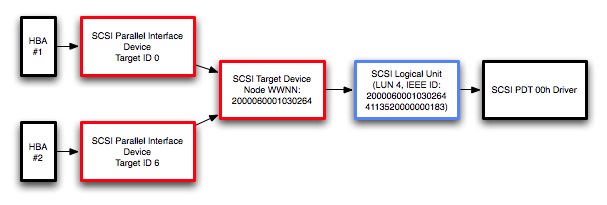Multipathing with FibreChannel on Mac OS X
Describes what is required of FibreChannel target hardware and host bus adapter drivers to take advantage of multipathing on Mac OS X
Introduction
The purpose of multipathing is to allow a single device to be connected to a host computer by more than one path, providing both redundancy and load balancing for increased performance. This technote explains what is required to make your host bus adapter (HBA) drivers and FibreChannel target devices compatible with the multipathing support in Mac OS X.
Support for multipathing began shipping with Mac OS X 10.3.5. It's important to be aware that Apple’s multipathing implementation differs significantly from that of other storage vendors. Many vendors implement multipathing support at the logical unit level whereas Mac OS X implements multipathing at the target device level. As a result, multipathing currently does not get enabled on Mac OS X for many 3rd party storage solutions
Multipathing Implementation used by Mac OS X
Mac OS X provides multipathing support on a per-target basis. Multipathing at the LUN level is not currently supported. The support for multipathing is provided by the IOSCSIArchitectureModelFamily KEXT and will be automatically enabled for devices that implement the required characteristics in firmware.

IOSCSIArchitectureModelFamily requires that all targets using multipath support show the same LUN configuration. RAID controllers and other hardware that broadcast the same world-wide node name (WWNN) for multiple target interfaces but do not publish their LUNs symmetrically are not compatible with this multipathing approach and will exhibit undesirable characteristics and behavior.
Load balancing across available paths to a device is done using a pressure-based algorithm. This algorithm attempts to keep the amount of outstanding I/O equal across all connections to a device by assigning new I/O requests to the port with the least amount of outstanding I/O.
Although its primary function is to provide multipathing support across FibreChannel, this same technology is implemented as part of the Mac OS X SCSI support and could potentially be used across other implementations of SCSI as well. To support a different interface, you will need to either extract or synthesize a WWNN for each target you are connecting to. On FibreChannel, the WWNN is part of the information available for every node attached to the fabric.
Supporting Multipathing in your HBA Driver
If you are implementing a host bus adapter (HBA), have your HBA set the kIOPropertyFibreChannelNodeWorldWideNameKey property for each target device. This property is mandatory for FibreChannel controllers and optional for most other interfaces.
If your HBA does not need to dynamically discover targets added after boot (that is, returns false from DoesHBAPerformDeviceManagement and relies on IOSCSIParallelFamily to discover any targets when the HBA becomes active), you can call SetTargetProperty from inside InitializeTargetForID to add the kIOPropertyFibreChannelNodeWorldWideNameKey property to the new target.
Listing 1 Setting the kIOPropertyFibreChannelNodeWorldWideNameKey key for non-managed targets.
bool
com_foo_sampleAdapter::DoesHBAPerformDeviceManagement ( void )
{
// Report that we *DO NOT* manage our own devices - we rely on the OS to discover targets for us
return false;
}
bool
com_foo_sampleAdapter::InitializeTargetForID ( SCSITargetIdentifier targetID )
{
bool retVal = false;
OSData *targetWWNN = NULL;
// [...]
// Do any other target-specific setup here
// Set the WWNN to a hard-coded value for demonstration purposes
// In the real world, you would obtain the WWNN for each target node
// from your FibreChannel HBA
targetWWNN = OSData::withBytes("12345678", 8); // 64-bit WWNN
SetTargetProperty(targetID, kIOPropertyFibreChannelNodeWorldWideNameKey, targetWWNN);
targetWWNN->release();
retVal = true;
return retVal;
} |
Alternatively, if your HBA is handling the creation and destruction of targets itself, locate the WWNN for the target and pass it to CreateTargetForID as a member of the properties dictionary.
Listing 2 Setting the kIOPropertyFibreChannelNodeWorldWideNameKey key for managed targets.
bool
com_foo_sampleAdapter::DoesHBAPerformDeviceManagement ( void )
{
// Report that we *DO* manage our own devices - we will query all possible targets ourselves
return true;
}
bool
com_foo_sampleAdapter::addNewTarget ( SCSITargetIdentifier targetID )
{
bool retVal = false;
OSDictionary *targetDictionary = NULL;
OSData *targetWWNN = NULL;
targetDictionary = OSDictionary::withCapacity(2); // Just a small dict
// [...]
// Do any other target-specific setup here
// Set the WWNN to a hard-coded value for demonstration purposes
// In the real world, you would obtain the WWNN for each target node
// from your FibreChannel HBA
targetWWNN = OSData::withBytes("12345678", 8); // 64-bit WWNN
targetDictionary-> setObject(kIOPropertyFibreChannelNodeWorldWideNameKey, targetWWNN);
targetWWNN->release();
CreateTargetForID(targetID, targetDictionary);
targetDictionary->release();
retVal = true;
return retVal;
} |
Supporting Multipathing in your SCSI Target Device
If you are implementing a target device, your device must publish results for INQUIRY page 83h, Device Identification Page, in binary format and provide either a EUI-64 or FCNameIdentifier.
LUNs that are not presented symmetrically are currently not supported on Mac OS X. It is recommended that you provide a mechanism to allow a user to configure your target devices so that all LUNs are reported symmetrically.
Related Information
Technical Committee T10, SCSI Storage Interfaces
Darwin Source Code, particularly the IOSCSIArchitectureModelFamily and IOSCSIParallelFamily source
Document Revision History
| Date | Notes |
|---|---|
| 2007-03-23 | Added important notes about the requirement to set the physical interconnect property in the protocol characteristics to Fibre Channel and about requiring unique SCSI domain identifiers for each connection. |
| 2007-02-23 | New document that an explanation on how FibreChannel multipathing works on Mac OS X and how to design storage hardware to take advantage of it |
Copyright © 2007 Apple Inc. All Rights Reserved. Terms of Use | Privacy Policy | Updated: 2007-03-23